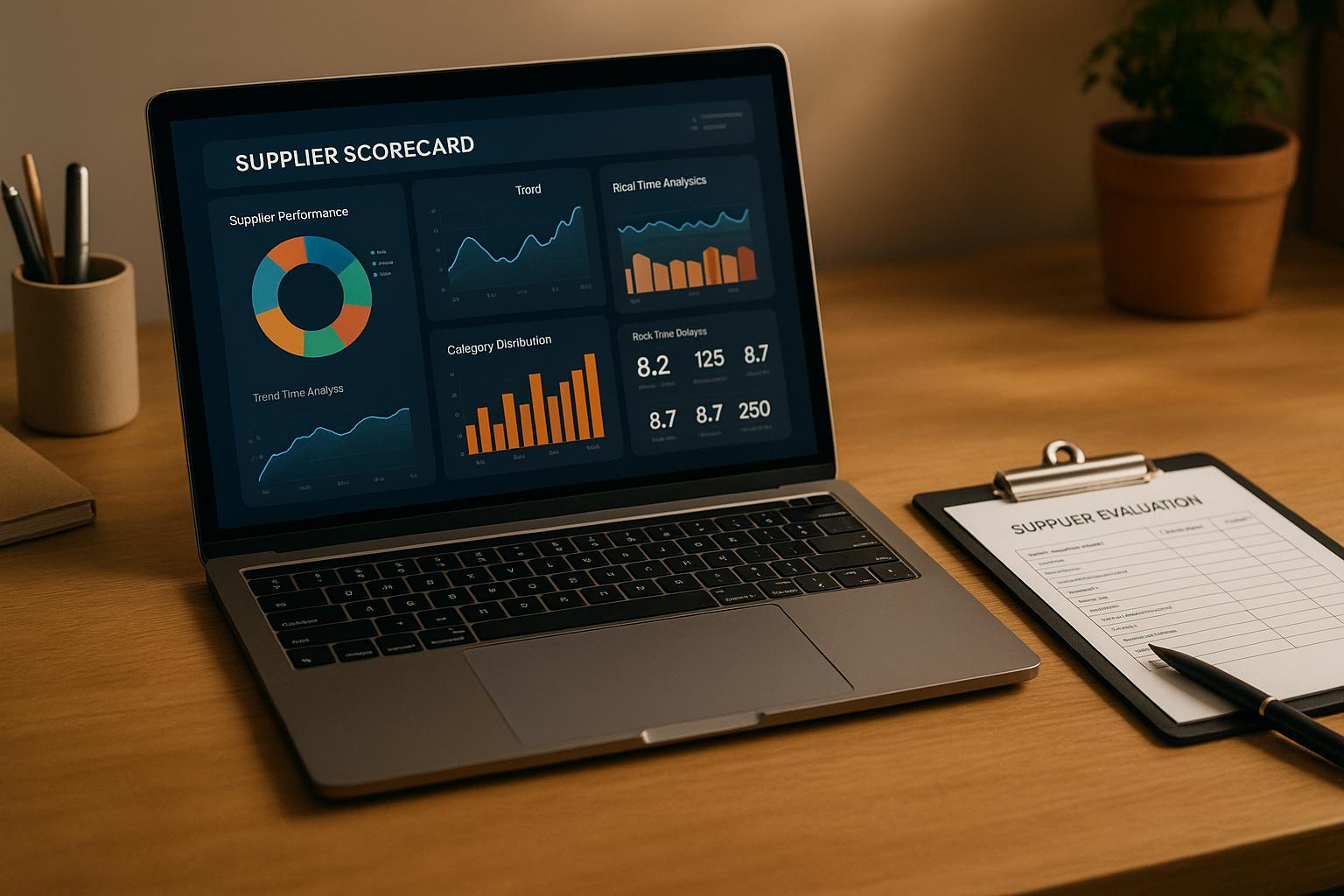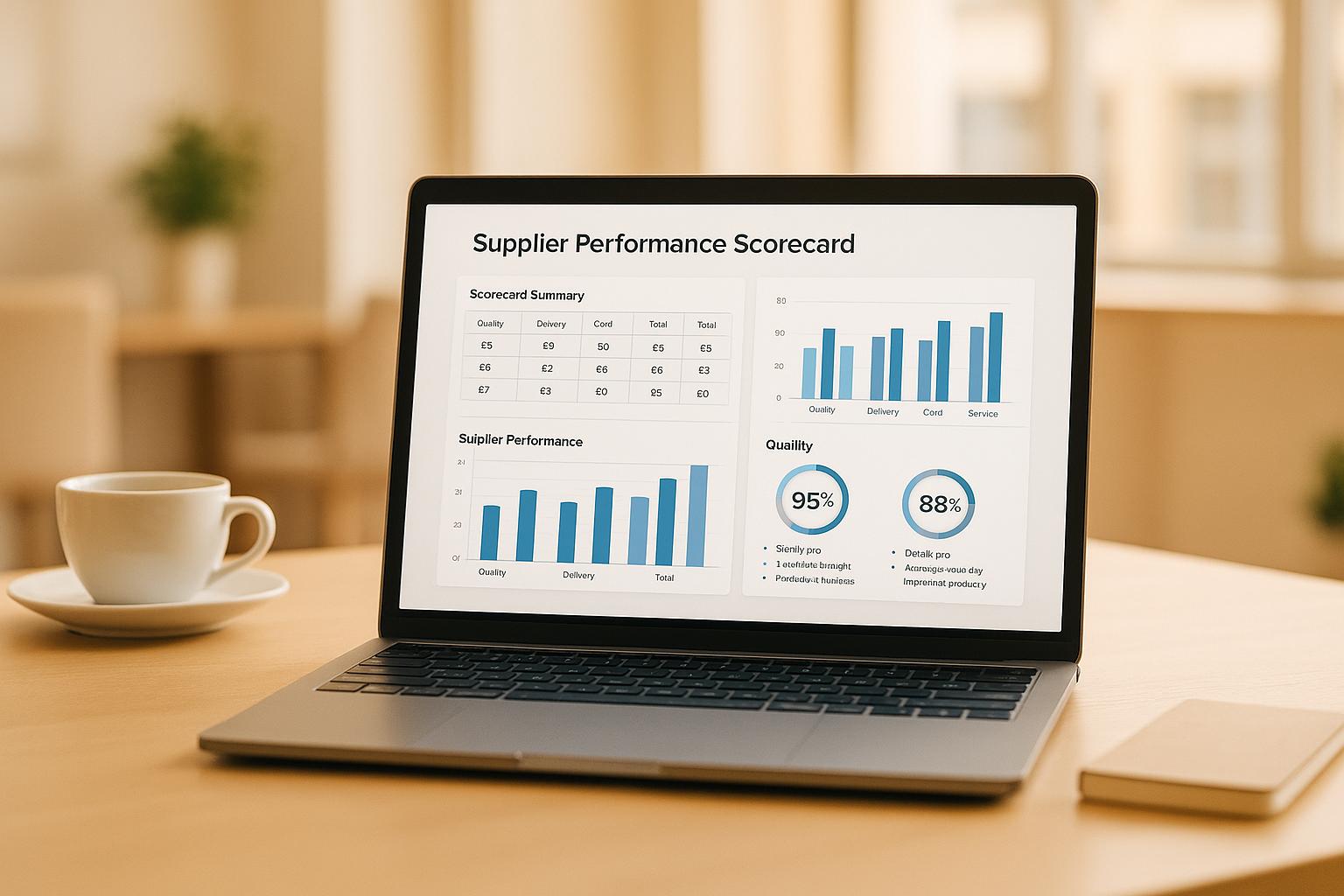Manual vs Automated Supplier Follow-up: A Complete Guide
.png?width=50&height=50&name=julie-miller-square%20(1).png)
Struggling with supplier follow-ups? Automation can save you time, reduce errors, and improve efficiency compared to manual methods. Here's the quick takeaway:
- Manual Follow-Up Issues: Time-consuming, prone to errors, costly, and lacks real-time updates.
- Automation Benefits: Cuts processing time by 30%, reduces errors, saves 50% on labor, and provides real-time tracking and insights.
Quick Comparison
| Feature | Manual Process | Automated Process |
|---|---|---|
| Processing Time | Slow and labor-intensive | 30% faster |
| Error Rate | High risk of mistakes | Minimal errors |
| Cost Per Invoice | $9 per paper invoice | $3–6 per digital invoice |
| Data Visibility | Limited and outdated | Real-time tracking |
| Staff Efficiency | Full-time focus on follow-ups | 50% time saved for buyers |
Switching to automation improves operations, saves costs, and strengthens supplier relationships. Ready to learn how? Keep reading for a complete breakdown.
Supplier 360: Automation around End-to-End Procurement ...
Common Problems with Manual Follow-Up
Manual supplier follow-ups can overwhelm resources and inflate costs. Here’s a closer look at the main challenges organizations encounter with these outdated methods.
High Time and Labor Costs
Manual follow-ups consume significant time and effort. Teams often spend hours each day:
- Entering orders by hand
- Following up through phone calls and emails
- Cross-checking data across multiple sources
- Updating ERP systems manually
These tasks pull focus away from more strategic supplier management activities. As order volumes increase, so do labor costs, making the process even less efficient.
Errors in Manual Processes
Relying on manual methods often leads to mistakes like missed orders, incorrect data entries, or incomplete information. These errors can ripple through the supply chain, causing production delays, higher shipping expenses, and damaged supplier relationships. Ultimately, these issues can hurt customer satisfaction and increase operational costs.
Outdated Information and Limited Visibility
When updates are delayed or communication gets lost, teams are left working with outdated data. Disconnected systems and limited visibility mean supply chain managers often have to react to problems instead of preventing them. This lack of real-time updates makes it harder to address issues before they escalate.
These problems highlight why automated tools are essential for faster, more accurate updates, helping to simplify and improve supply chain operations.
How Automated Follow-Up Improves Operations
Automated supplier follow-up systems transform supply chain operations by streamlining processes and improving efficiency. Here's a closer look at how these systems enhance key operational areas.
Faster Processing Times
Automated systems handle purchase orders - sending, tracking, and processing them instantly. This eliminates the need for hours of manual data entry and follow-up. Procurement teams can then shift their focus to more strategic tasks, as the system takes care of tasks like order acknowledgments and shipment notifications. The result? Quicker operations with fewer errors.
Improved Data Accuracy
Automation significantly reduces data entry errors through features like:
- Real-Time Price Updates: Any supplier price changes are immediately reflected in ERP records, minimizing errors in forecasting and invoicing.
- Order Verification: The system ensures suppliers receive and acknowledge orders, avoiding issues like:
- Production delays
- Expensive rush shipping
- Inventory shortages
- Documentation Management: AI-powered tools accurately capture data from supplier communications, keeping records precise and up-to-date.
These features not only prevent operational hiccups but also strengthen supplier relationships by ensuring smooth, error-free communication. Additionally, dashboards provide instant insights, helping teams manage suppliers more effectively.
Real-Time Tracking Dashboard
Modern automated systems offer centralized dashboards that provide full visibility into supplier performance:
| Feature | Benefit |
|---|---|
| Response Times | Monitor acknowledgment times and response rates |
| On-Time Delivery | Track adherence to delivery schedules and quality |
| Performance Analytics | Create detailed supplier scorecards |
| Integration Capabilities | Seamlessly connect with ERP systems |
These dashboards allow teams to:
- Monitor vendor responsiveness
- Track open orders in real time
- Access detailed shipment data
- Generate performance reports
With ERP integration, teams get up-to-date delivery dates and order statuses, enabling faster and more informed decision-making.
sbb-itb-b077dd9
Manual vs Automated: Direct Comparison
Manual and automated follow-up systems show clear differences in terms of efficiency, accuracy, and overall business outcomes. Here's a breakdown of key metrics that highlight these contrasts.
Performance Metrics Comparison
The table below compares the core operational metrics of manual and automated systems:
| Metric | Manual Process | Automated Process | Impact |
|---|---|---|---|
| Processing Time | Standard cycle time | 30% faster processing | Quicker order fulfillment |
| Document Management | 7% yearly document loss | Digital storage with instant access | Improved record management |
| Cost per Invoice | $9 per paper invoice | $3–6 per digital invoice | 50–75% cost savings |
| Staff Efficiency | Full-time focus on follow-ups | 50% time saved for buyers | Lower labor expenses |
| Error Rate | High risk of manual mistakes | Dramatically reduced errors | Better accuracy |
These figures reflect the practical advantages of automation, showcasing how it streamlines operations and addresses the limitations of manual systems.
Manual processes often lead to challenges like missed orders, pricing discrepancies, and higher operational costs. In contrast, automated systems consistently deliver better results by cutting costs, reducing errors, and strengthening supplier relationships.
"We're now able to keep our customers happier because we can finally now answer their questions about where their stuff is."
- Erin Purvis, Supply Chain, Blu Dot
5 Steps to Switch to Automated Follow-Up
Automation can save time, reduce errors, and improve supplier communication. Follow these steps to transition from manual processes to automated follow-ups.
Review Current Methods
A January 2024 case study highlights how a manufacturing company lost $25,000 in production costs and spent an additional $5,000 on expedited shipping due to a missed purchase order.
When reviewing your current methods, focus on these key areas:
- Time spent on tasks like emailing purchase orders (POs) and updating ERP systems
- Financial impact caused by manual errors
- Delays in supplier communication
- Labor costs and expenses related to errors
For example, in Q3 2024, a distribution company faced a $15,000 cost discrepancy due to outdated supplier pricing. Resolving the issue required 15 hours of reconciliation work.
Once you’ve identified your challenges, you can choose tools that directly address these pain points.
Select Automation Tools
When selecting automation software, look for features that solve your specific challenges and integrate smoothly with your existing systems. Key features to consider include:
| Feature | Purpose | Impact |
|---|---|---|
| ERP Integration | Ensures accurate data | Eliminates manual updates |
| Custom Follow-up Cadences | Automates supplier communication | Reduces manual tracking |
| Real-time Visibility | Monitors order status | Prevents delays and stockouts |
| Supplier Scorecards | Tracks vendor performance | Strengthens supplier relationships |
| PO Automation | Simplifies order management | Speeds up processing |
Implementation Steps
- Data Migration Planning: Review and clean up supplier data, purchase orders, and communication templates.
- System Integration: Connect your ERP system to the automation platform to maintain a smooth flow of data.
- Team Training: Educate your procurement team on how to use the new system and workflows.
- Pilot Program: Test the system with a small group of reliable suppliers to ensure smooth operation.
- Full Deployment: Expand the automation system across your entire supplier network.
"Leverage is a total game-changer for us. I can't believe we managed our supply chain without this level of visibility before." - Eric Swope, COO, Buckle Down
The benefits are clear: 74% of users report revenue growth within three months of implementation, and 96% see a major drop in out-of-stock situations.
Conclusion: The Impact of Automated Follow-Up
As we’ve seen, manual methods often fall short of meeting the demands of modern supply chains. Moving to automated supplier follow-ups can transform operations by increasing efficiency and cutting costs.
Steve Andrews, a director, highlights the impact of automation with a 50% reduction in weekly time spent on follow-ups and fewer staffing needs. Erin Purvis from Blu Dot emphasizes how this shift enhances customer satisfaction:
"We're now able to keep our customers happier because we can finally now answer their questions about where their stuff is".
Eric Swope, COO of Buckle Down, shares how automation has revolutionized their supply chain management:
"Leverage is a total game-changer for us. I can't believe we managed our supply chain without this level of visibility before".
With better visibility, companies can deliver superior service and build stronger customer relationships. The benefits of automation - speed, accuracy, and transparency - are undeniable.
Here’s a quick summary of the measurable improvements automation can bring:
| Impact Area | Key Benefits | Measurable Results |
|---|---|---|
| Time Management | Automated tracking | 50% less time spent on follow-ups |
| Customer Service | Real-time updates | Faster, more accurate responses |
| Operational Efficiency | Fewer manual tasks | Reduced need for additional staff |
As supply chains grow more complex, automated follow-up systems are becoming a critical tool for staying competitive. Companies that adopt automation can scale their operations more effectively while maintaining high levels of service and operational efficiency.
FAQs
What are the key steps for a company to move from manual to automated supplier follow-ups?
To successfully transition from manual to automated supplier follow-ups, start by centralizing your purchase order data in one system. This ensures full visibility into incoming orders and inventory levels, helping you stay organized and informed.
Next, replace manual communication with automated, pre-configured outreach to suppliers. Integrate your system with existing tools like ERPs, EDI platforms, and email to streamline the collection of real-time order updates. This reduces errors, saves time, and improves supplier communication.
By adopting an automated approach, you can enhance efficiency, reduce manual workload, and scale your processes to meet growing demands.
How does automation enhance supplier relationships compared to manual follow-up methods?
Automation enhances supplier relationships by streamlining communication and ensuring consistent, real-time updates. Unlike manual methods, automated systems reduce delays in sharing critical information like purchase orders, shipment statuses, and delivery timelines. This fosters trust and reliability between you and your suppliers.
Additionally, automated tools provide valuable insights into supplier performance, helping you identify trends, address issues proactively, and make data-driven decisions. By improving accuracy and responsiveness, automation creates a smoother, more collaborative partnership with your suppliers.
What are the most important features to look for in an automation tool for supplier follow-up?
When choosing an automation tool for supplier follow-up, focus on features that enhance efficiency, accuracy, and visibility in your supply chain. Look for tools that offer real-time updates, automated communication (like order acknowledgments), and seamless integration with your existing ERP systems.
Key features to prioritize include:
- Supplier scorecards to evaluate performance and identify trends.
- Open order tracking for better visibility into order statuses.
- Predictive analytics to anticipate potential delays and optimize planning.
These capabilities can significantly improve supplier collaboration, reduce manual effort, and streamline operations, making your supply chain more scalable and reliable.
.png?width=50&height=50&name=julie-miller-square%20(1).png)

